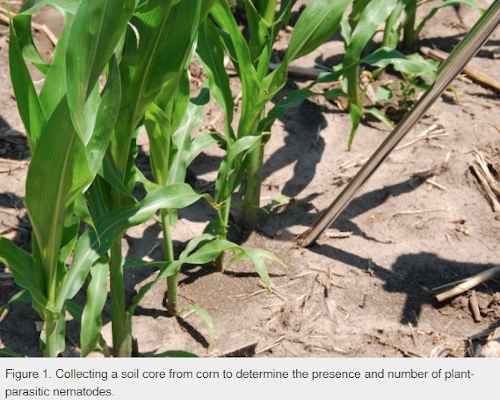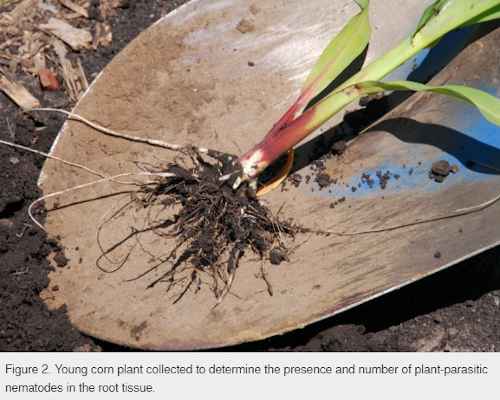Up to corn growth stage V6: collect soil and root samples
- Use a soil probe, angle underneath a corn plant and collect soil cores that are at least 12 inches long (see Figure 1).
- Collect 20 or more soil cores to represent an area.
- Collect soil cores from within the root zone of plants with symptoms of damage. Combine (but do not mix) soil cores and place in a sealed plastic bag labeled with permanent marker.
- Also collect, with a shovel, the root mass from 4 to 6 plants with symptoms of damage (see Figure 2). Take care not to strip off the smaller, seminal roots. The tops of the plants can be cut off and discarded. Place the roots in a sealed plastic bag labeled with permanent marker.
- Protect samples from physical jarring and keep samples cool (at or below room temperature).


Corn growth stage V6 through R3 (milk): collect only soil samples
- Use a soil probe, angle underneath a corn plant and collect soil cores that are at least 12 inches long (see Figure 1).
- Collect 20 or more soil cores to represent an area.
- Collect soil cores from within the root zone of plants showing symptoms of damage. Combine (but do not mix) soil cores and place in a sealed plastic bag labeled with permanent marker.
- Protect samples from physical jarring and keep samples cool (at or below room temperature).
Corn growth stage R4 (dough) and later: sampling not recommended
There is not a reliable relationship between damage or yield loss and the number of nematodes present in soil and roots once the corn crop reaches the R4 growth stage.
Where to send samples?
Samples for nematode analysis can be sent to some private soil-test laboratories in Iowa and surrounding states. Check with the lab to determine if they process nematode samples for corn before sending the samples. Many university plant disease clinics and nematode diagnostic labs also process samples for nematodes on corn. A list of the university laboratories and their contact information is available online.
Iowa State University’s Plant and Insect Diagnostic Clinic processes samples for nematodes that feed on corn. The test is called the complete nematode count. Samples sent to the ISU Clinic should be accompanied by a Nematode Sample Submission Form (ISU Extension Publication "PIDC 32"). There is a $35 per sample processing fee ($40 per sample for out-of-state samples).
Managing nematode damage on corn
If damaging population densities of nematodes are found in a corn field, there is nothing that can be done during the season to slow the build-up of nematode numbers and lessen the yield loss. Management options for future corn crops include using soil-applied Counter® 20G nematicide and/or seed treatments such as Aveo™, Avicta®, Escalate, Nemastrike™, Trunemco™, and Votivo®.
Source : iastate.edu